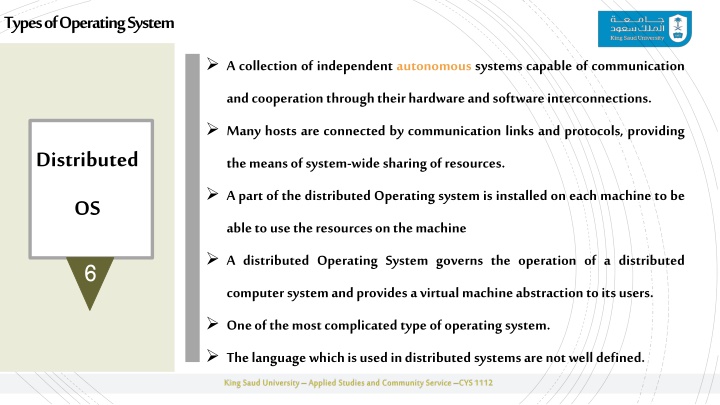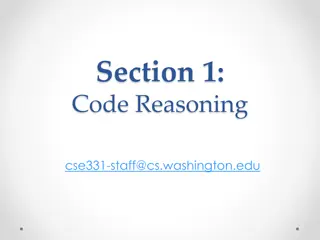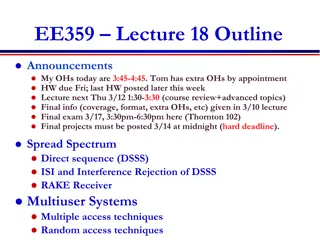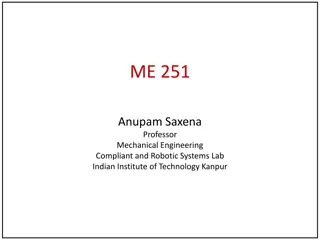
Types of Operating Systems and Their Functions
"Explore the different types of operating systems including distributed, network, and peer-to-peer systems, along with their functions in managing resources and user interactions. Learn about command-based and system call user interfaces in operating systems."
Download Presentation

Please find below an Image/Link to download the presentation.
The content on the website is provided AS IS for your information and personal use only. It may not be sold, licensed, or shared on other websites without obtaining consent from the author. If you encounter any issues during the download, it is possible that the publisher has removed the file from their server.
You are allowed to download the files provided on this website for personal or commercial use, subject to the condition that they are used lawfully. All files are the property of their respective owners.
The content on the website is provided AS IS for your information and personal use only. It may not be sold, licensed, or shared on other websites without obtaining consent from the author.
E N D
Presentation Transcript
Types of Operating System A collection of independent autonomous systems capable of communication and cooperation through their hardware and software interconnections. Many hosts are connected by communication links and protocols, providing the means of system-wide sharing of resources. A part of the distributed Operating system is installed on each machine to be able to use the resources on the machine A distributed Operating System governs the operation of a distributed computer system and provides a virtual machine abstraction to its users. One of the most complicated type of operating system. The language which is used in distributed systems are not well defined. Distributed OS 6 King Saud University Applied Studies and Community Service CYS 1112
Types of Operating System Network Operating System (NOS) Manages the relationship between network resources and users. NOS are operated on a server which provide the managing of data, security, users, applications, and other networking functions. To main part to most of Network Operating Systems - Server: Is a computer or device, usually very powerful, which the network resource reside and manages the network resources. - Client: The application that runs on a computer and depends on the server to preform the required operations. Example: MacOS X, MS Windows Server 2003, Sun Solaris, Novell NetWare. Network OS 7 King Saud University Applied Studies and Community Service CYS 1112
Types of NOS Network Operating Systems made accessing shard resource more user friendly, which resulted the growth and becoming the daily necessity. There are two types of We can conclude from our definition that the operating system preforms two main function: The Server would provide the service to the other machine in the network. The Client using a program it would request the service from the server Examples: Sending Email and using LMS Client-Server System The peers has equal privilege, were each peer can be the provider or the client at the same time without the need to centralize machines in between. Examples: Sharing files using Torrent and some network games. Peer to Peer System King Saud University Applied Studies and Community Service CYS 1112
Different view of Operating System Users of the Operating System services are divided into two broad classes: Command-language: Users are those who obtain services of the Operating System by means of command. Typed through a terminal or embedded in batch. System-call: Users invoke services of the Operating System by means of run-time system calls. Usually embedded in and activated during execution of programs. King Saud University Applied Studies and Community Service CYS 1112
The Command-Language Command languages are usually system-specific. Even though syntax differs from one system to another, nonetheless the range and functionality of system commands are not very different. Some of the most common functional classes: File-management: CREATE, DELETE, RENAME, COPY Status reporting: LIST-ACTIVE PROGRAMS, LOGGED_USERS Program activation and control: LOAD, RUN, ABORT King Saud University Applied Studies and Community Service CYS 1112
The System-Call Invoke services by system and applications programmers, through the programs by means of system calls, are sometimes called Application-Programming interfaces (APIs). Command-language are normally converted and executed, as a series of system calls. Along with providing most of the functionality available to command-language, system calls usually allow finer control over system operations. System calls for execution and control of programs usually include a full set of services available via the command language such as RUN, EXECUTE, ABORT. King Saud University Applied Studies and Community Service CYS 1112
question Is Time sharing operating system considered multiprogram or multitasking? Why ? Why there are different types of OS? What are the pros and cons of using the command language always? King Saud University Applied Studies and Community Service CYS 1112
End of Second Lecture King Saud University Applied Studies and Community Service CYS 1112









